|
SEVEN "SUMMER" SCENES
(without leaving home!)
"Art is the recreation of mood in line, form and color.
If I were confined to my own backyard for the rest of my life,
I'd still have more pictures in my mind than I would have time to paint.
Art is nothing but having a good time."
- Richard Hayley Lever, Australian / American, 1876-1958
FIRST TO CORNWALL, ENGLAND :
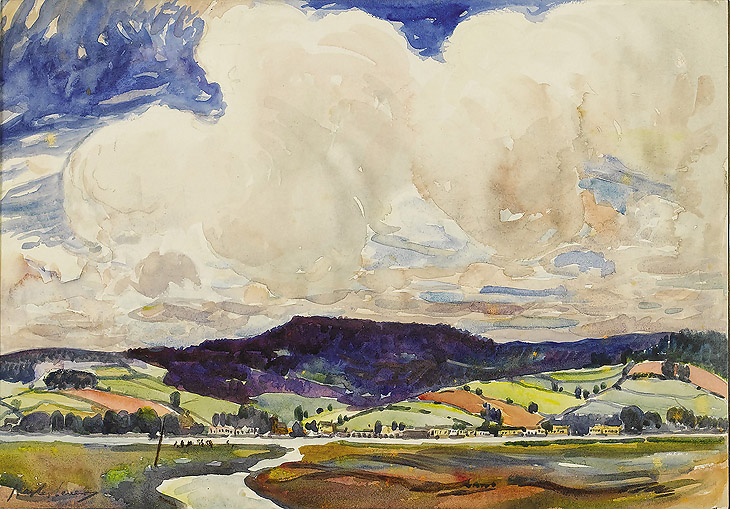
RICHARD HAYLEY LEVER
Australian / American, 1876-1958
"DEVONSHIRE RIVER"
Watercolor on paper, with gallery notation on matting verso
Housed in a 22K giltwood frame and linen liner
Provenance: Estate of Leonard Clayton of Clayton-Liberatore Gallery,
37th Street, New York, formerly Leonard Clayton Gallery, New York, NY
(supporter and agent for Lever during his lifetime and after).
Lever, with an early inheritance, traveled from Australia to England to study,
eventually settling in Cornwall,
where he "painted views of the town and harbor, as well as scenes of Devon,
interpreting the maritime environment with soft, Whistlerian brushwork".
In 1912, at the suggestion of several American artists he met in St. Ives,
Lever traveled to New York, where he quickly established a major reputation
in national art circles, winning awards and prizes at the annuals of the
National Academy of Design, National Arts Club, and Pennsylvania Academy of Fine Arts.
Lever became a member of New York's most prestigious art organizations,
including the National Academy of Design and National Arts Club (Artist Life Member).
As well as exhibiting
at New York's Macbeth Gallery,
his affiliations included Daniel Gallery, Milch Galleries,
and the Clayton-Liberatore Gallery
Lever's Cornwall scenes are known for their brilliance and luminosity.
This is a superb example!
Image Size: 9.25" High x 13.5" Wide 
THENCE OVER TO PARIS :
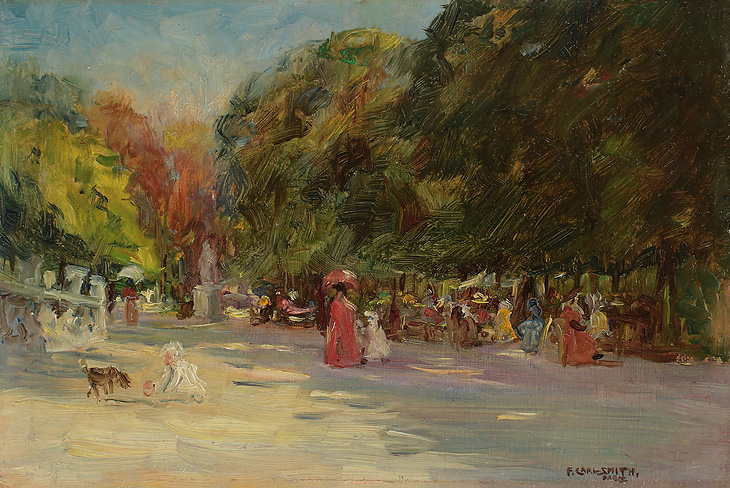
FREDERICK CARL SMITH
American (California / Washington DC) 1868-1955
"LUXEMBOURG GARDENS, PARIS, FRANCE", Paris, c1895
Oil on panel, signed and inscribed lower right : F. Carl Smith / Paris
Note: Founding Member of the Laguna Beach (CA) Art Association
This is an
extraordinary small plein air work
by Frederick Carl Smith,
executed in Paris, c1895, during the 10 year period in which he studied
at the Académie Julian with Bouguereau, Ferrier, and Constant.
When in Paris, Smith also exhibited at the Salon in 1897, and in 1899.
Upon his return to the United States in 1900, he worked in Washington DC,
primarily as a portraitist, exhibiting at the National Academy of Design (1900) and the Corcoran
Gallery (1908) (among others). In 1917, he moved to California, where he became
one of the founding members of the Laguna Beach Art Association.
This amazing small masterwork depicts with ease and perfection
16 figures, a dog, statue and fountain - each by only a few strokes
or squiggle of the brush, in the dappled light of Luxembourg Gardens.
Image Size : 6.25" High x 9.5" Wide 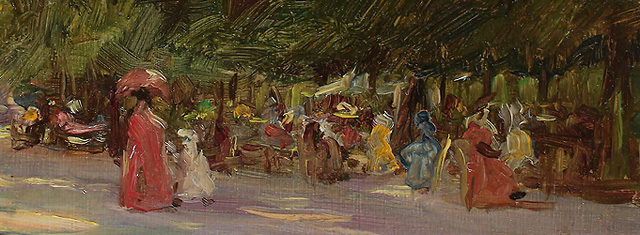
AND ON TO MUNICH :
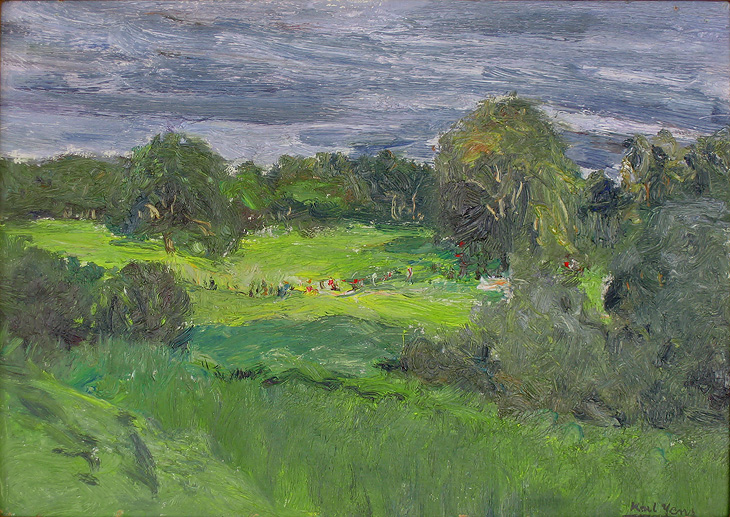
KARL JULIUS HEINRICH YENS
German / American / California (1868-1945)
"THE FAMOUS JENISCH PARK, ELBE GERMANY, 1931"
Oil on board / Signed lower right; the verso with two labels :
"Historical Collection of the Laguna Beach Museum of Art...... with catalog #84.17";
another in German; and a penned inscription :
"The Famous Jensich Park, near Flottbek 6/Blankenese o/Elbe, Germany"
"Karl Yens, Laguna Beach Calif. 1931"
Housed in what appears to be the original Arts & Crafts frame, its texture echoing the
energetic directional brushwork, contrasted by minute strokes depicting a parade of people
Provenance: Laguna Beach Museum of Art, Laguna Beach CA
Jenisch Park is the in Hamburg district, and home to the neoclassical Jenisch-Haus,
and the Ernst-Barlach-Haus, a museum housing sculpture, drawings, and printed graphic art.
Prior to coming to American, Yens had studied in Europe with Max Koch in Berlin,
and Benjamin Constant and Jean-Paul Laurens at the Académie Julian in Paris.
Yens immigrated to America in 1901, first filling mural commissions in New York City and
Washington, D.C. In 1910, he settled in Southern California, moving to Laguna Beach in 1918.
He was a member / exhibitor of the Laguna Beach Art Association, among many others, and
co-founded the Laguna Beach Art Association and the Modern Art Society.
Yens exhibited and won numerous medals and awards in Southern California, and is represented in many
California museums and collections, as well as the Smithsonian National Portrait Gallery, Washington DC.
Image size: 10" High x 14" Wide

BACK TO THE US, and MANHATTAN :
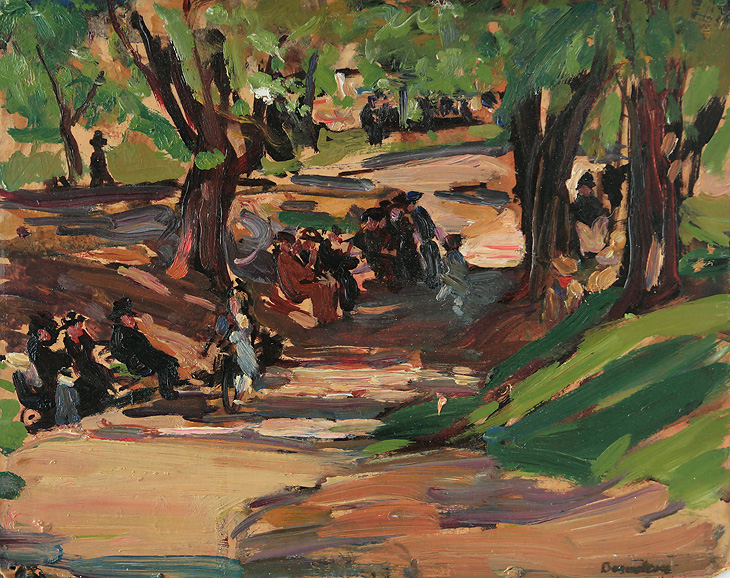
THERESA FERBER BERNSTEIN
New York / Massachusetts (1890-2002)
"SUNNY PATH, CENTRAL PARK, c1917"
Oil on board / Signed lower right
Housed in a reproduction giltwood American Impressionist frame
Exhibited: New York : Empire City. Grand Central Art Galleries, New York, label verso
Boldly painted in directional impasto manner, this small figurative image depicts life in Central Park
early 20th century. The strength of the work is exactly what Ms. Bernstein was so well known for :
"rapid, fluid brushwork, innovative color play, and fresh approach";
"plein-air landscape painting with startling color contrasts and bright accents of light".
The combination of energetic contrasts of light, line, freedom and precision in the work are arresting,
as well as the simple examination of life and activities - executed with passion but without sentimentality.
A member of the Ash Can School as early as 1910,
she continued to produce "vibrant canvases" for 8 more decades.
However, this early period remains my choice -
perhaps as she was still a great admirer of Robert Henri,
whose composition and brushwork are echoed here.
Henri was her idol, but sadly she never got to study with him - although she lived to be 110 years old.
Image Size : 9" Wide x 11.5" High
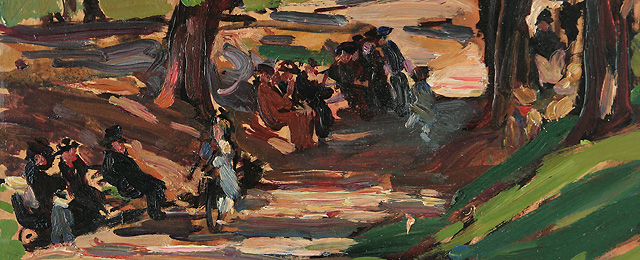
UP THE COAST TO GLOUCESTER, MASSACHUSETTS :

GEORGE LOFTUS NOYES
American, Massachusetts, 1864-1954
"A BLUE DAY, GLOUCESTER"
Oil on Canvas on Board
Signed, titled and inscribed "Gloucester" on the reverse
Housed in a 22K giltwood reproduction American Impressionist frame
Noyes was one of the most highly respected early 20th century landscape painters in Boston.
He was known for his "en plein air" method, learned enrolled in Paris at the ateliers of
Gustave Courtois, Joseph-Paul Blanc, and Paul-Louis Delance.
He traveled throughout New England seeking the best subject matter,
focusing upon the countryside around Boston, the North Shore and the White Mountains.
In 1898 began painting and traveling with Frederic Edwin Church.
During the summer of 1901 and again in 1921,
Noyes became an early teacher to Newell Convers Wyeth, who stated :
"His color knowledge is superb and I think he will give me much help at this juncture".
This luminous and painterly work is not only about color, but
"en plein air" - about the quality of light and the feel of the air -
yet with retention of the finest details just in the right places
Provenance : An Eastern Connecticut collection, with letter of authentication
Image Size: 9.5" High x 15.5" Wide
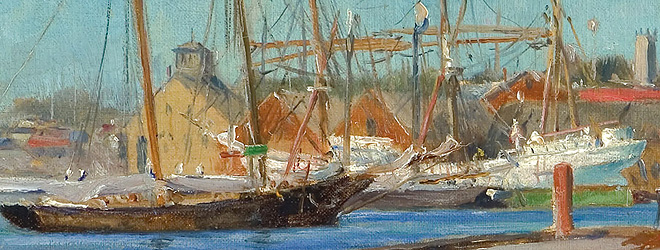
And Inland To
SOUTH EGREMONT (Western Massachusetts) :
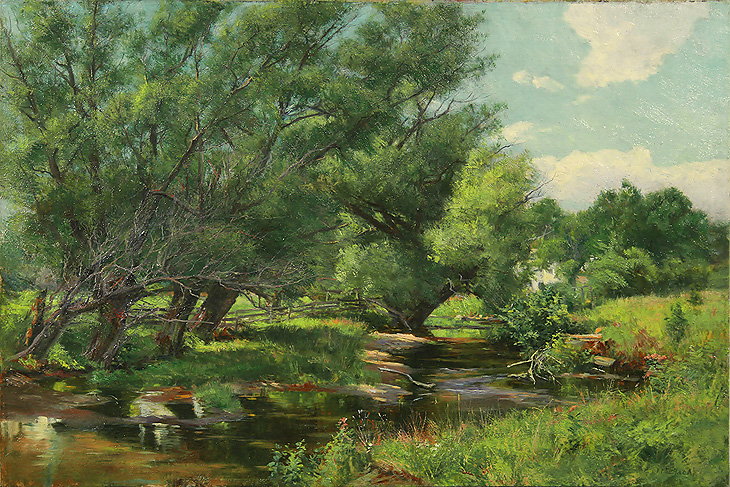
OLIVE PARKER BLACK
American (New York / Massachusetts) 1868-1948
"STREAM THROUGH A SUMMER LANDSCAPE"
Oil on Canvas / Signed lower right O.P. Black
Housed in the original carved giltwood frame
Olive Parker Black is best known as a landscape painter of the Northeastern United States.
Her Hudson River school paintings also incorporated the influence of her teachers:
Barbizon from Hugh Bolton Jones at Art Students League;
free brushwork and impressionism from William Merritt Chase at NY National Academy of Design.
She was considered one of Chase's best students.
She exhibited at the National Academy of Design from 1897 to 1930,
in Boston with the Boston Art Club, and in Philadelphia at the Art Club of Philadelphia.
In 1910, she moved from her native Cambridge,
Massachusetts to New York City,
where she exhibited at the National Academy (1897-1930), as well as the Carnegie Institute.
She was a member of the National Association of Women
Artists, National Academy of Design,
New York Society of Painters, American Artists Professional
League and Copley Society (Boston).
After her move from Cambridge New York City,
Olive Parker Black continued to summer at South Egremont, Massachusetts,
where she painted many of her finest rural landscape,
as this one, in its original carved giltwood frame.
Image Size: 16.25" High x 24.25" Wide
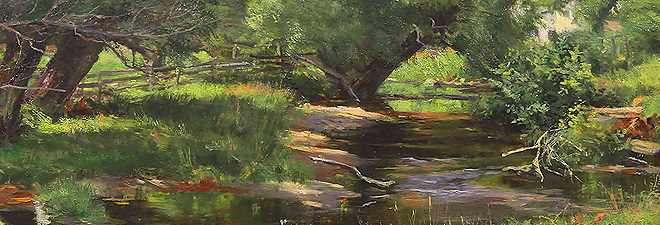
And Finally Westward,
TO THE
DORLAND MOUNTAINS of SOUTHERN CALIFORNIA
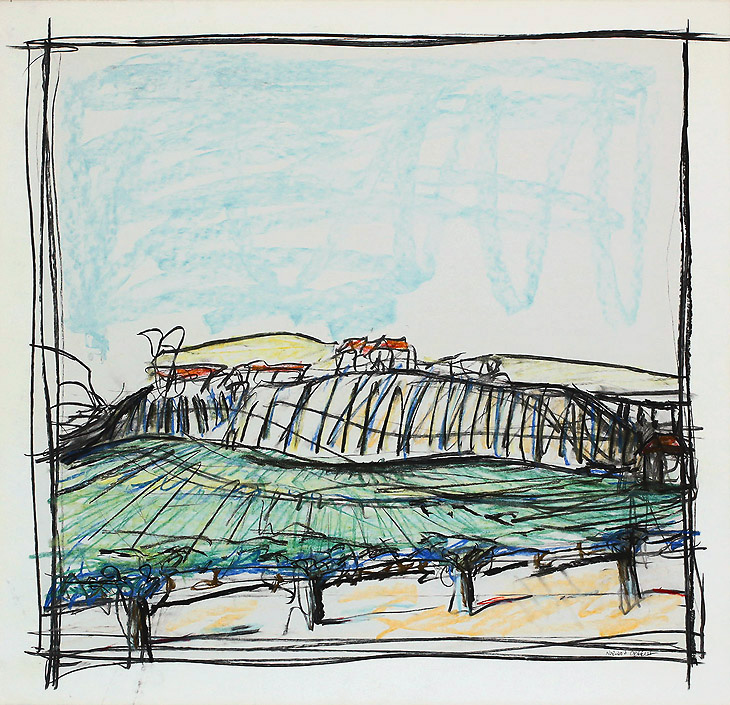
NORWOOD CREECH
American South / Contemporary
"TEMECULA VINEYARD"
Pastel, Charcoal & Graphite on Paper / Signed Lower Right
Housed in a giltwood cap frame with linen liner and gilt fillet
Norwood Creech is the third generation in a family of female painters,
each well schooled in the classical traditions in both painting and drawing.
Norwood's distinctive approach combines the best of these classical aspects
with a contemporary spirit of energy and brevity.
Consistent in Norwood’s work is a spirited, free and searching line.
Her unique line was recognized and encouraged in her studies with both
California painter Wayne Thiebaud, and Arkansas printmaker Evan Lindquist.
It was Thiebaud who, in 1993, directed Norwood toward
the work of Alberto Giacometti, citing a similar characteristic of line.
She has exhibited in Arkansas, California, Arizona, New Mexico and Tennessee,
with several one-woman exhibitions in Arkansas regional museums and galleries.
Norwood was active in Southern California, from 1987 to 1992,
where at varioius times she served as Assistant to Director of Education, Laguna Art Museum,
and Outreach Educator for Bowers Museum (Santa Ana).
As well, she was a charter member Laguna Outreach Community Artists (LOCA).
In 1999, she was granted a residency
at Dorland Mountain Artist Colony, in Southern California,
where she returned to paint, including
the Temecula vineyards depicted here.
Image Size: 33.25" High x 35.25" Wide

Notes of Interest :
Southern California, Laguna Beach Museum and
Art Associations,
as well as "en plein air", are mentioned several times in the text above.
About 1860, varying theories and interests in Europe began to explore
different approaches to representing "light" in fine art.
This pursuit gave birth to working "en plein air",
representing the fleeting moment,
including the quality of the light and air.
In the late 1800s, many American painters going to study in France were
exposed to this method of painting and its particular palettes,
bringing the techniques back to both coasts of America.
The 1890s saw this first encroachment of the new "impressionism" in California.
The Southern California light had a great similarity to that of the South of France,
already a choice for many international painters.
This similar light – and the climate –
drew painters from the American East Coast as well as from Europe.
To capture "the delicate and fleeting effect of California's light",
"en plain air" necessitated an on-site direct, quick application of paint,
often as short strokes, thickly applied.
This technique became a characteristic of "California Impressionism"
really flowering about 1900, possibly reaching its zenith in the 1940's,
and still executed and popular today.
Five of the artists above are among those drawn to Southern California,
particularly Laguna Beach. They include :
Richard Hayley Lever
Frederick Carl Smith
Karl Yens
George Loftus Noyes
(already working "plein air", and in California in the early 1900s)
Norwood Creech
Inventory Images : Millicent F. Creech
|